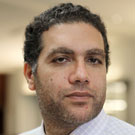News & Events > Department News
Seminar: Professor Khaled Nabil Salama
 Memristor-based memory:
Memristor-based memory:
The sneak paths problem and solutions
Thursday, August 15th at 10:30am
EE Building, PAC AE 108
Host: M. P. Anantram (Please contact anant@uw.edu if you would like to meet the speaker Prof. Salama).
Abstract
The memristor (M) is considered to be the fourth two-terminal passive element in electronics, alongside the resistor (R), the capacitor (C), and the inductor (L). Its existence was postulated in 1971, but its first implementation was reported in 2008. Where was it hiding all that time and what can we do with it? Come and learn how the memristor completes the roster of electronic devices much like a missing particle that physicists seek to complete their tableaus. The future of memristors is being modeled today at KAUST. Recently, the memristor has been explored as a futurereplacement for the current CMOS-based memories and SolidState Drives (SSD). One of the main challenges hindering the realization of memristor based memories, from a circuits and architecture point of view, is the sneak-paths phenomenon. Several other techniques were proposed in an attempt toaddress the sneak-paths problem without the use of gating elements. We introduce the first closed-form solution forthe sneak-paths based on a multipoint reading method. The proposed method eliminates the effect of all the sneak-paths by evaluating a simple addition/subtraction operation on the different readings of the system.
Bio
Dr. Salama received his bachelor's degree with honors from the Electronicsand Communications Department at Cairo University in Egypt in 1997, and his master'sand doctorate degrees from the Electrical Engineering Department at Stanford Universityin the United States, in 2000 and 2005 respectively. He was an assistant professor at RPI between 2005 and 2008. He joined King Abdullah University of science and technology (kaust) in January 2009 and was the electrical engineering founding program chair till August 2011. His work on CMOS sensors for molecular detection has been funded bythe National Institutes of Health (NIH) and the Defense Advanced Research ProjectsAgency (DARPA), awarded the Stanford-Berkeley Innovators Challenge Award inbiological sciences and was acquired by Lumina Inc in 2008. He is the cofounder of ultrawave labs, a biomedical imaging company thats VC funded. He is the co-author of 90 papers and 10 patents on low-power mixed-signal circuits for intelligent fullyintegrated sensors and non linear electronics specially memristor devices. He is a seniormember of IEEE.





